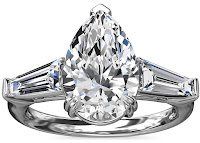 |
Photo: Lands' End
|
Even as an adult, my mother sometimes gives me, shall we say, "unsolicited advice." She might adopt, then cling fiercely to a puzzling obsession for a period of time, pleading her case in the most relentless and funny way every chance she gets. One year her obsession was to get me to wear more turtleneck sweaters. And we couldn't watch the Nightly News together without her pointing out, how the accomplished Ms. Diane Sawyer (the anchor of the broadcast) was wearing a turtleneck. Said Mom, "See, every successful woman wears one! It's why she has such an important job." |
Photo: Appleseed. If my Mom sees this image, she might say, Look how happy this woman is in her turtleneck! 😊
|
Poor Mom to have a daughter unlike herself. In fact, a turtleneck isn't my favorite style of sweater. I think I only have one in my wardrobe. I haven't seen it in a while as I only pull it out on the coldest day of the year.
My favorite style of sweater is a cardigan. I have many of them in red and neutral colors for winter including black, navy blue, and gray; and in bright pastel colors for summer, such as turquoise, hot pink, red, sapphire blue, and teal.
I have a couple of pullover sweaters, but it's the cardigans I wear. Having a front opening and being able to button and unbutton a sweater helps me to regulate my body's temperature, I suppose. If I get hot in lieu of taking off my sweater, I can simply unbutton it. And, I also like the understated, polished look of a cardigan sweater, which you can dress up or down with the right skirt, trousers, shoes, and accessories. Easy, stylish dressing!
I like 100% Supima cotton cardigans for the summer and 100% cashmere or 100% merino wool cardigans for the winter. An ex-sailor (of the U.S. Navy) once told me that 100% wool sweaters keep you the warmest on moist rainy days. A good tip! Here's a 2nd tip: I like my cardigans long. A sweater length extending to the upper thigh is dressier, as well as, makes you look taller by drawing the eye to your legs.
IMHO cotton, cashmere, and wool are the most comfortable, wearable, and durable fabrics. You pay the piper once, but keep the cardigans for decades, so over time you truly get your money's worth in not having to rebuy them. Furthermore, in sweaters I tend to pass on fabric blends like cotton-modal or cashmere-nylon since my experience is, they don't tend to fit or hold up as well. These are basic rules of thumb sans finding a too-good-to-be-true deal.
 |
| Photo: L.L. Bean |
Retailers I turn to for cardigans include Lands' End, Uniqlo, and L.L. Bean. L.L.Bean tends to offer chunky sweaters, while Lands' End and Uniqlo style sleeker cardigans. Sleeker (smoother and fitted) sweaters are usually dressier and more versatile while chunky sweaters are more casual. However, styles came and go, so a fresh browse from time to time is neccesary. Uniqlo, the Japanese innovative retailer, always has the best-priced cotton, cashmere, and merino wool cardigans -- and they hold up for years. All 3 merchants have Crewnecks and V-necks, as well as, an assortment of other sweater styles like pullovers and yes, turtlenecks.
A classic cardigan will always be a wardrobe staple and my favorite style. Sorry, Mom! Perhaps you can get your other daughter to wear more turtlenecks.😉 On that's right, I'm her only daughter. Dear Mamà means well.💋
You may also enjoy:











































